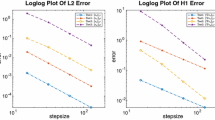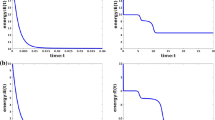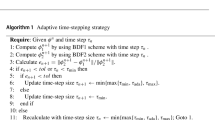Abstract
We present a mixed finite element method for the thin film epitaxy problem. Comparing to the primal formulation which requires \(C^2\) elements in the discretization, the mixed formulation only needs to use \(C^1\) elements, by introducing proper dual variables. The dual variable in our method is defined naturally from the nonlinear term in the equation, and its accurate approximation will be essential for understanding the long-time effect of the nonlinear term. For time-discretization, we use a backward-Euler semi-implicit scheme, which involves a convex–concave decomposition of the nonlinear term. The scheme is proved to be unconditionally stable and its convergence rate is analyzed.
Similar content being viewed by others
References
Arnold, D.N., Falk, R.S.: A uniformly accurate finite element method for the Reissner–Mindlin plate. SIAM J. Numer. Anal. 26, 1276–1290 (1989)
Bathe, K.J., Dvorkin, E.N.: A four-node plate bending element based on Mindlin–Reissner plate theory and a mixed interpolation. J. Numer. Methods Eng. 21, 367–383 (1985)
Bathe, K.J., Brezzi, F.: On the convergence of a four-node plate bending element based on Mindlin–Reissner plate theory and a mixed interpolation. In: Whiteman, J.R. (ed.) MAFELAP V, pp. 491–503. Academic Press, London (1985)
Bathe, K.J., Brezzi, F.: A simplified analysis of two plate-bending elements-the MITC4 and MITC9 elements. In: Pande, G.N., Middleton, J. (eds.) MUNETA 87. Numerical Techniques for Engineering Analysis and Design, vol. 1 (1987)
Berkovitz, L.D.: Convexity and optimization in \({\mathbb{R}}^n\). Wiley, New York (2002)
Blomker, D., Gugg, C.: On the existence of solutions for amorphous molecular beam epitaxy. Nonlinear Anal. Real World Appl. 3, 61–73 (2002)
Brezzi, F., Fortin, M.: Numerical approximation of Mindlin-Reissner plates. Math. Comp. 47, 151–158 (1986)
Brezzi, F., Bathe, K.J., Fortin, M.: Mixed interpolated elements for Reissner–Mindlin plates. J. Numer. Methods Eng. 28, 1787–1801 (1989)
Caflisch, R.E., Gyure, M.F., Merriman, B., Osher, S., Ratsch, C., Vvedensky, D.D.: Island dynamics and the level set method for epitaxial growth. Appl. Math. Lett. 12, 13–22 (1999)
Chen, W., Conde, S., Wang, C., Wang, X., Wise, S.M.: A linear energy stable scheme for a thin film model without slope selection. J. Sci. Comput. 26, 1–17 (2011)
Cho, A.: Film deposition by molecular beam techniques. J. Vac. Sci. Technol. 8, S31–S38 (1971)
Cho, A., Arthur, J.: Molecular beam epitaxy. Prog. Solid State Chem. 10, 157–192 (1975)
Clarke, S., Vvedensky, D.D.: Origin of reflection high-energy electron-diffraction intensity oscillations during molecular-beam epitaxy: a computational modeling approach. Phys. Rev. Lett. 58, 2235–2238 (1987)
Copetti, M.I.M., Elliot, C.M.: Numerical Analysis of the Cahn–Hilliard equation with a logarithmic free energy. Numer. Math. 63, 39–65 (1992)
Du, Q., Nicolaides, R.A.: Numerical analysis of a continuum model of phase transition. SIAM J. Numer. Anal. 28, 1310–1322 (1991)
Duran, R., Liberman, E.: On mixed finite element methods for the Reissner–Mindlin plate model. Math. Comp. 58, 561–573 (1992)
Elliot, C.M., French, D.A.: Numerical studies of the Cahn–Hilliard equation for phase separation. IMA J. Appl. Math. 38, 97–128 (1987)
Elliot, C.M., French, D.A.: A nonconforming finite-element method for the two-dimensional Cahn–Hilliard equation. SIAM J. Numer. Anal. 26, 884–903 (1989)
Elliot, C.M., French, D.A.: A second order splitting method for the Cahn–Hilliard equation. Numer. Math. 54, 575–590 (1989)
Eyre, D.J.: Unconditionally gradient stable time marching the Cahn–Hilliard equation. In: Bullard, J.W., Kalia, R., Stoneham, M., , Chen, L.Q. (eds.) Computational and Mathematical Models of Microstructural Evolution, p. 1712. Materials Research Society, Warrendale (1998)
Feng, X., Prohl, A.: Error analysis of a mixed finite element method for the Cahn–Hilliard equation. Numer. Math. 99, 47–84 (2004)
Gyure, M.F., Ratsch, C., Merriman, B., Caflisch, R.E., Osher, S.: Level-set methods for the simulation of epitaxial phenomena. Phys. Rev. E 58, R6927–R6930 (1998)
Han, W., Cheng, X., Huang, H.: Some mixed finite element methods for biharmonic equation. J. Comp. Appl. Math. 126, 91–109 (1999)
Hoppe, R.H., Nash, E.M.: A combined spectral element/finite element approach to the numerical solution of a nonlinear evolution equation describing amorphous surface growth of thin films. J. Numer. Math. 10, 127–136 (2002)
Johnson, C., Pitkäranta, J.: Analysis of some mixed finite element methods related to reduced integration. Math. Comp. 38, 375–400 (1982)
Kang, H.C., Weinberg, W.H.: Dynamic Monte Carlo with a proper energy barrier: surface diffusion and two-dimensional domain ordering. J. Chem. Phys. 90, 2824–2830 (1989)
King, B.B., Stein, O., Winkler, M.: A fourth-order parabolic equation modeling epitaxial thin film growth. J. Math. Anal. Appl. 286, 459–490 (2003)
Kohn, R.V., Yan, X.: Upper bounds on the coarsening rate for an epitaxial growth model. Commun. Pure Appl. Math. 56, 1549–1564 (2003)
Krug, J.: Origins of scale invariance in growth processes. Adv. Phys. 46, 139–282 (1997)
Li, B.: High-order surface relaxation versus the Ehrlich–Schwoebel effect. Nonlinearity 19, 2581–2603 (2006)
Li, B.: Variational properties of unbounded order parameters. SIAM J. Math. Anal. 38, 16–36 (2006)
Li, B., Liu, J.: Thin film epitaxy with or without slope selection. Eur. J. Appl. Math. 14, 713–743 (2003)
Li, B., Liu, J.: Epitaxial growth without slope selection: energetics, coarsening, and dynamic scaling. J. Nonlinear Sci. 14, 429–451 (2004)
Lu, X., Lin, P., Liu, J.: Analysis of a sequential regularization method for the unsteady Navier–Stokes equations. Math. Comp. 77, 1467–1494 (2008)
Malkus, D.S., Hughes, T.J.R.: Mixed finite element methods-reduced and selective integration techniques: a unification of concepts. Comput. Methods Appl. Mech. Eng. 15, 63–81 (1978)
Ortiz, M., Repetto, E., Si, H.: A continuum model of kinetic roughening and coarsening in thin films. J. Mech. Phys. Solids 47, 697–730 (1999)
Rost, M.: Continuum models for surface growth. Int. Ser. Numer. Math. 149, 195–208 (2005)
Schneider, M., Schuller, I.K., Rahman, A.: Epitaxial growth of silicon: a molecular-dynamics simulation. Phys. Rev. B 36, 1340–1343 (1987)
Scholtz, R.: A mixed method for fourth-order problems using the linear finite elements. RAIRO Numer. Anal. 15, 85–90 (1978)
Scott, L.R., Zhang, S.: Finite element interpolation of nonsmooth function satisfying boundary conditions. Math. Comp. 54, 483–493 (1990)
Siegert, M., Plischke, M.: Solid-on-solid models of molecular-beam epitaxy. Phys. Rev. E 50, 917–931 (1994)
Villain, J.: Continuum models of crystal growth from atomistic beams with and without desorption. J. Phys. I 1, 19–42 (1991)
Wang, C., Wang, X., Wise, S.: Unconditionally stable schemes for equations of thin film epitaxy. Discrete Contin. Dyn. Syst. 28, 405–423 (2010)
Xia, X., Chen, W., Liu, J.: Convergence analysis of implicit full discretization for the epitaxial growth model of thin films. Numer. Math. J. Chin. Univ. 34(1), 30–51 (2012). (in Chinese)
Xu, C., Tang, T.: Stability analysis of large time-stepping methods for epitaxial growth models. SIAM J. Numer. Anal. 44, 1759–1779 (2006)
Acknowledgments
Chen was supported by the 111 project, Key Project National Science Foundation of China (91130004) and the Natural Science Foundation of China (11171077). He also thanks Jianguo Liu in Duke University and Xiaoming Wang in Florida State University for the fruitful discussions. Wang thanks the Key Laboratory of Mathematics for Nonlinear Sciences (EYH1140070), Fudan University, for the support during her visit. The authors are also grateful to the anonymous referees for their helpful comments and suggestions which greatly improved the quality of this paper.
Author information
Authors and Affiliations
Corresponding author
Rights and permissions
About this article
Cite this article
Chen, W., Wang, Y. A mixed finite element method for thin film epitaxy. Numer. Math. 122, 771–793 (2012). https://doi.org/10.1007/s00211-012-0473-9
Received:
Revised:
Published:
Issue Date:
DOI: https://doi.org/10.1007/s00211-012-0473-9




